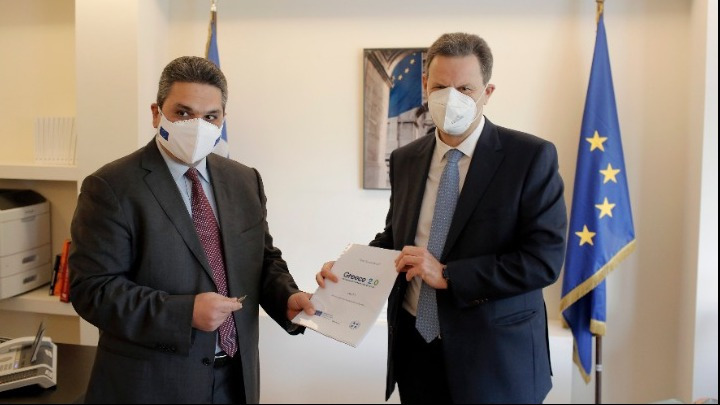
Greece formally submitted its national recovery plan to the European Union on Tuesday, which is aimed at helping repair the economic and social damage caused by the coronavirus pandemic.
President of the EU Commission Ursula von der Leyen acknowledged receipt and said: “Good to see that it focuses on strategic areas for the country’s future: green & digital, jobs, skills, private investment and reform.”
We have received Greece's Recovery & Resilience plan.
Good to see that it focusses on strategic areas for the country's future: green & digital, jobs, skills, private investment and reform.
After assessment 🇬🇷 could receive up to €30.5 billion under #NextGenerationEU
— Ursula von der Leyen (@vonderleyen) April 28, 2021
Under the multi-billion euro coronavirus recovery plan agreed upon by European Union leaders last year, Greece is to receive 18.2 billion euros ($21.96 billion) in grants and 13 billion euros in inexpensive loans over the coming years, equal to about 16% of its gross domestic product.
It is expected to get added leverage from the private sector via equity capital and loans, meaning the total funds for investments will be increased to nearly 60 billion euros.
Prime Minister Kyriakos Mitsotakis said last month the country’s four-pillar scheme, dubbed “Greece 2.0,” would help revive and transform an economy still emerging from the shadow of a decade of severe financial crisis.
Αlternate Finance Minister Theodoros Skylakakis, in charge of the Recovery Fund, said that the plan includes 106 investment programs and 67 reforms that are accurately described and costed in 4,104 pages.

Delivering the document to the EU representatives in Athens, the Greek minister added: “The first step was taken. Now the even more difficult task of absorbing the huge resources of the Fund follows, which will allow the country to realize not only a dynamic recovery, but to enter a permanent long-term course of development and change of its productive model, for the benefit of all Greek society.”
Greece’s National Recovery and Sustainability Plan
According to the government, the primary goal of the Greek Recovery Plan is to fill the large gap in investment, national product and employment — an endemic gap in the performance of the Greek economy over the last decade — which has worsened due to the COVID-19 pandemic.
In this context, the National Recovery and Sustainability Plan aims to mobilize significant forces from the private sector, boosting private investment and using Public-Private Partnerships and Energy Service Companies to make significant public investment efforts.
The Greek Recovery Plan consists of four pillars: Green, Digital, Social, and Economic and Institutional reform.
1. Green transition. The investments of the Greek Recovery Plan include, inter alia:
– Extensive program “savings” for households, businesses, public buildings and infrastructure.
– The interconnection of the Greek islands, which will significantly reduce the energy costs of households and businesses and energy storage investments that will allow the best utilization of the country’s potential in renewable energy sources.
– Promotion of strategic urban actions for development of their environmental value.
– Large investments in flood control projects, accompanied by changes in the use of irrigation networks and installation of telemeters for leak detection and smart water management.
– A new National Reforestation Plan.
– Initiatives to protect biodiversity.
– Large investments in infrastructure and equipment of the Civil Protection authority.
– Investments for the elaboration of urban plans that will inform validly and immediately regarding land use for 4/5 of the country.
2. Digital transition. The investments of the Plan include, inter alia:
– Pre-installation of fiber optic infrastructure in buildings to facilitate the transition to the use of fiber optic networks by businesses and households.
– Development of 5G network corridors on Greek highways.
– Connection of the mainland with modern underwater fiber optic cables with the Greek islands.
– Digitization of key files in various sectors (health, justice, town planning, land registry, immigration, etc.) and their integration into respective information systems.
– Ensuring the interconnection and interoperability of systems and individual registers and individual applications between public bodies.
– Information system for the management of transactions of the Public Administration with the citizens and businesses.
– Investments to battle tax evasion, which include further digitization of tax services, codification and modernization of tax legislation, actions against smuggling and the use of artificial intelligence to facilitate tax audits, enhance electronic transactions, etc.
– Digital transformation of companies, with the acquisition of equipment, cloud services and internet services, such as new electronic payment technologies, electronic invoicing, remote work, digital office, etc.
3. Private investment and economic reform. The Plan includes, inter alia:
– Strong incentives for private investment (green, digital transformation, innovation, extroversion).
– Important infrastructure projects such as the northern part of the E65, the Northern Road Axis of Crete, a major road safety project, major irrigation projects through PPPs, the modernization also through PPPs of the railway network, a new suburban railway in Western Attica, tolls, “smart” infrastructure, etc.
– Investments for the strengthening of culture, such as the creation of the Museum of Underwater Antiquities in Piraeus, development of cultural and natural routes and a program for the protection of emblematic monuments from climate change, etc.
– Investment in tourism with interventions for mountain tourism, health tourism and the use of thermal springs, gastronomy, upgrading of tourist ports, diving tourism, access to beaches and special training programs to upgrade the skills of the human resources of tourism business.
4. Social cohesion and employment. The plan also includes, inter alia:
– Employment programs aimed at increasing employment with particular emphasis on the development of digital skills and digital transformation of education.
– Development of digital infrastructure in classrooms and interactive learning.
– Upgraded equipment in laboratories and research centers.
– Vouchers for purchasing computers and tablets for vulnerable households so children can familiarize themselves with digital tools.
See all the latest news from Greece and the world at Greekreporter.com. Contact our newsroom to report an update or send your story, photos and videos. Follow GR on Google News and subscribe here to our daily email!



